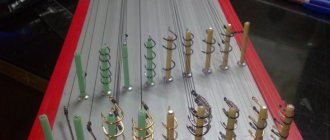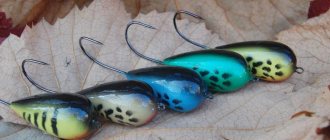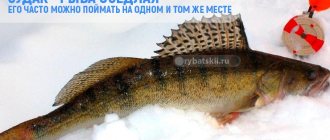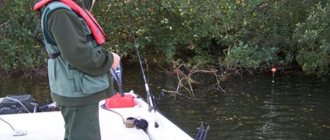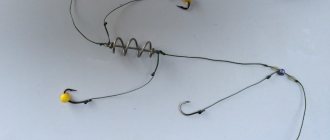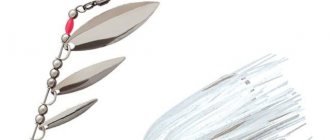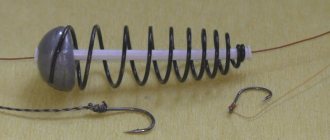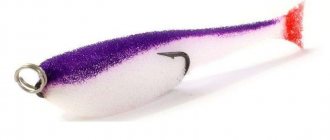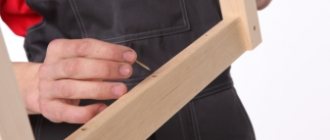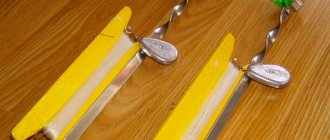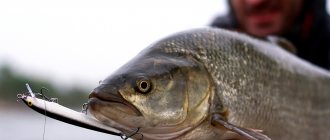A leash for pike fishing is one of the remarkable calling cards of this type of hunting for the most common predator of our freshwater bodies. Without this accessory, it is almost impossible to catch a toothy one, because equipment from any type of fishing line caught in the mouth in most cases is easily bitten by the fish, leaving the angler without a trophy. Regardless of the method of fishing for predators, anglers use leashes made of materials that can withstand the sharpness of pike teeth.
Many manufacturers of fishing products produce this element of equipment in different sizes and from materials with different characteristics, but experienced pike fishermen like a homemade leash, with special qualities that have a positive effect on the play of baits and the delicacy of the equipment. The topic of the article will be a review of the materials from which this element of pike equipment is produced, as well as effective recommendations for making leashes at home.
Requirements for leashes
A pike leash must meet a number of important requirements, because its importance in the reliability of any installation plays a major role. The main requirement for the leader material is its high wear resistance to abrasion, which is precisely what contributes to the conditions for resisting the action of a pike’s mouth, stuffed with teeth as sharp as blades. An important requirement is also considered to be the high breaking load parameters of the material used for the leashes. After all, as you know, pike are the type of fish that never give up when caught without a fierce fight. Another of the main requirements for the accessory is the selection of the optimal length of the leash, which promotes unhindered play of the bait, and is also comparable to the size of the fish’s mouth, preventing it from biting the cord itself when grabbing the bait.
Reviews from experienced fishermen
“If you catch pike, you only need to use a metal leash. She will either bite the other leash or simply grind it off. When fishing in winter, it may happen that it is rubbed by the edge of the ice when the fish is already rising from the water. I don’t think the visibility of the leash is such a big problem.” Grade:
Ivan
“If you take a fluorocarbon leash thick enough, the pike will not bite through it. It should be thicker than 0.4 millimeters." Grade:
Sergey
“Yes, I tried both steel string and tungsten. But pike are more interested when I use regular fishing line. Fluorocarbon is very effective, and it’s also completely invisible in the water.” Grade:
Peter
Materials, their advantages and disadvantages
Pike leashes in the classic version are made of steel. The thin core allows it to withstand tearing under heavy loads and resist abrasion. But the disadvantages of steel are its large mass and high levels of residual memory; moreover, at sharp bend angles, the material is prone to creases. Tungsten options are much softer than steel and are not subject to oxidation, but also have high memory and are heavy.
The durable material titanium, from which the lightest, most flexible and memoryless leashes are made, is disappointing only with its high cost, comparable for the price of one unit of titanium leash to the cost of a couple of seasons of active fishing when purchasing accessories made of steel and even tungsten. Kevlar, a synthetic fiber, is increasingly being used in pike fishing, claiming to be a universal leader material. It is plastic, not prone to stretching and has virtually no memory effect. But bulkiness and lack of resistance to sharp teeth hinders the leadership of this type of material. The same can be said about fluorocarbon. The general characteristics of plasticity and high transparency provide obvious advantages for pike fishing and especially for passive fish, but durability requires better results and expectations.
How to choose leader material for pike
First of all, we note that in order to talk about this, you need to understand what types of such fishing gear can exist.
They are usually distinguished according to the following characteristics:
- Taking into account the material from which the leash is made.
- Rigidity.
- The degree to which it is visible to a predator in the water.
- According to the mounting method.
We must remember not only that this fish is a predator, but also that its teeth are not only sharp, but at the same time strong and powerful. If this circumstance is not taken into account, this may lead to the fact that the fisherman may lose not only his trophy, not only his hook and leash, but also his catchy bait.
Types of leashes for pike
The leader material affects not only the reliability of the fishing itself, but also the play of baits, which are very diverse in pike hunting, and the methods of mounting live baits also depend to a large extent on the type of this element of equipment. Methods for attaching the accessory to the main cord and mounting the hook may differ depending on the specific design features of the leashes. In continuation of the article, we will take a more specific look at the structural features of the pike mounting equipment based on the material used for the leashes, specifying the fastening elements and the structural structure of the accessory itself.
Steel leashes
Steel is the most common and affordable driving material. In addition, it is characterized by low cost . To produce the product, steel wire up to 0.4 mm thick is used. The length of the steel version of the lead can reach 30 cm. Steel leashes are distinguished by their large mass, and their low plasticity limits the freedom of baits. But at the same time, steel makes it easy to carry out rigs in overgrown areas of water areas, where softer materials get stuck in algae, disrupting the rhythm of the retrieve.
Important! Even thin steel can withstand heavy loads, subsequently, without losing its qualities, but the material is afraid of creases and is susceptible to corrosion, which critically reduces the strength and durability of use.
From thin steel threads, as a result of their weaving and subsequent coating with a polyethylene composition, a driving material is produced, which is characterized by increased ductility and higher performance qualities. Steel bends are equipped with a swivel and fastener.
Titanium
Titanium products are considered to be the most expensive fishing line accessories. This option is characterized by its durability. Titanium is not subject to abrasion and does not corrode in aggressive water environments. Even after a dozen pike attacks, the titanium thread does not change its shape, remaining smooth and unchanged in diameter. Despite significant advantages, titanium leashes are rarely used for pike fishing. As a rule, snags and subsequent irretrievable loss of the rig are common in pike fishing. A spinning pike fisherman has to put up with the fact that leashes are consumables, and the use of an expensive accessory in this situation does not seem like a rational idea.
Kevlar
Kevlar relatively recently appeared on the fishing market and immediately gained its reliable niche in the fishing environment. Synthetic fiber has made it possible to make pike rigs much more flexible and delicate in their sensitivity to predators and their influence on the animation of baits.
Important! Synthetic fiber can withstand high loads without floating in diameter, but it will not always be able to adequately survive a fish attack, being subject to micro cuts and, as a rule, subsequent destruction.
When factory assembled, the product includes a swivel and a carabiner. The length of the accessory ranges from 10–40 cm.
Fluorocarbon
Fluorocarbon line with a diameter of 0.35 mm is an excellent leader material. The transparency of the substance helps the angler to successfully catch passive and cautious fish. Products made from this type of fishing line are distinguished by their lightness, and their plasticity helps artificial baits work within their capabilities. These qualities make it possible to produce fluorocarbon leader mounts of large lengths, over 40 cm, without much concern for the deterioration of the performance of the baits. A negative characteristic of fluorocarbon is its weakness against pike teeth, which is expressed in fairly frequent cuts due to the aggressive behavior of the catfish.
Tungsten
Tungsten products are distinguished by their softness with significantly high breaking load parameters.
Important! This kind of leash has virtually no effect on the animation of the bait, but tungsten is afraid of any small deformations, not returning to its original shape.
Even the slightest contact of a predator with an accessory renders it unusable, which results in the shape of a pig’s tail, which scares off the trophy with its appearance and prevents the bait from playing. I am pleased with the low cost of the product, and therefore it can be used in a one-time version. Tungsten leashes are equipped with a clasp and a miniature swivel.
Selection rules
When fishing with a spinning rod, do not get carried away with long leashes; frequent overlaps are possible. A length of 8 cm is quite enough. Strength is of great importance. If you are going after trophy specimens, it is better to use titanium tackle. Yes, it is expensive, but it is strong and durable. However, any tackle of this kind can serve well if the storage and transportation conditions are followed.
Pay attention to the swivel and fastening rings. All this must be secured securely.
And finally, this material is very durable. In addition to strength and lack of memory for deformation, it is protected from all aggressive influences. It will not rust or weaken. Yes, the material is expensive, there is not much of it, but the leashes made from it are almost eternal. Only a break when hooked on a snag will force you to take the next leash, whereas with the usual steel leashes you have to lose 10-15 per fishing trip, if not more.
Date: April 10, 2021 | 620
In many styles of fishing, it is common to install leaders. At the end of the main fishing line or cord, a leash is tied - a piece of another fishing line or other material. Thus, leashes perform a number of functions, depending on the fishing method. And the driving material is selected for specific tasks. In this review we will deal with the topic of leashes and, of course, we will focus on leash materials designed to withstand the sharp and dangerous teeth of a pike.
The approach to leader materials is different for a variety of gear and types of fish:
Everyone knows that spinning gear uses leashes made of various materials for various purposes. Usually, the need for a leash is determined by one of three reasons: protecting the gear from the sharp teeth of a predator (pike); inconspicuousness of the outermost section of fishing line compared to the main fishing line or cord; using a stiffer leash to avoid the wobbler getting caught in the fishing line when twitching.
Pike teeth leashes are most often made of metal. These can be thin single-core leashes:
- String;
- Steel;
- Vole;
- Titanium;
- Various stranded materials.
The latest, multi-fiber, multi-strand driving materials, characterized by increased elasticity.
In a special place are fluorocarbon leashes of various thicknesses.
Now, let's talk about these materials in more detail, discuss the scope of their application in spinning equipment, depending on the conditions.
When catching pike, pike perch, catfish with jigs, spinners, wobblers with their own action, ordinary, fairly rigid leashes made of string, steel, and voles are widely used. These leashes come with an American clasp and a swivel. In the same conditions, moderately rigid multi-core driving materials are used.
[THERE IS AN ANSWER] How to anchor mugs for pike fishing
As for titanium, one cannot fail to note its excellent property - complete immunity to deformation. If the leash gets twisted, it is not thrown away, as when using other materials, but is easily straightened with your fingers and it regains its shape. Well, the price for such an indestructible leash is appropriate.
Elastic leader materials are good when fishing with a fairly elegant, light spinning rod, using light, medium-sized baits. On the one hand, such leashes reliably protect the tackle from the sharp teeth of the pike, and are soft enough to not spoil the action of the bait.
Thin fluorocarbon will no longer protect against pike teeth. But, due to its invisibility in the water, this material is often used in light and ultralight spinning rods when catching cautious river fish: asp, chub, trout.
I can mention Pontunovsky material as a very good option for leashes.
Leader material Pontoon 21 Stretch 7 0.2mm
- Diameter: 0.2mm
- Strength: 4kg
- Unwinding: 5m
- Type: Lead Material
- Black color
Secondly, the Stretch 7 leader tends to stretch under load, which gives better shock absorption when fighting large fish.
And finally, this material is very durable. In addition to strength and lack of memory for deformation, it is protected from all aggressive influences. It will not rust or weaken. Yes, the material is expensive, there is not much of it, but the leashes made from it are almost eternal. Only a break when hooked on a snag will force you to take the next leash, whereas with the usual steel leashes you have to lose 10-15 per fishing trip, if not more.
Triton 19 fiber leash
- Diameter: 0.15mm
- Length: 14 cm
- Material: American Fishing Wire
- Strength: 3 kg
The material of the Triton leash is 19-core so-called. "American lace" The material is soft, elastic, but resistant to pike teeth. The leash is strong, as for an ultralight - 3 kg at break. Accessories: small swivel and American clasp.
It is clear that branded materials have interesting properties and you can take them if you have the money and their characteristics can make a difference on your fishing trips. But you can completely eliminate this expense item, make leashes from steel or string, and not know any grief. This approach is especially relevant when fishing in snags. You don’t want to lose cool leashes along with expensive baits. If we tear it off, then, roughly speaking, the wire.
Re: LEASH. Materials, influence on bite, etc.
Storling
Re: LEASH. Materials, influence on bite, etc.
Pike cuts thin flare easily. The one who doesn’t cut it either rarely catches it or is still lucky. Not IMHO - just a fact. If you don't believe me, read this thread. So, for fishing with light baits, fluorine is not suitable as protection against teeth, unless it is disproportionately thick. For fairly heavy baits, thick flare - for God's sake.
GoldenTurtle
Re: LEASH. Materials, influence on bite, etc.
Storling
Re: LEASH. Materials, influence on bite, etc.
Re: LEASH. Materials, influence on bite, etc.
The second direction also remains unchanged for now - elastic metal multi-strand “cables”, the loops of which are fixed with the supplied clips. Or the ready-made leashes of different lengths and diameters offered - to suit the personal tastes of anglers and the need for something specific in specific fishing conditions dictate diversity here.
How to make a leash for a pike with your own hands
It is not difficult to make a leash for a pike with your own hands. For this work, you will need to purchase the material from which the product will be prepared, as well as additional elements for equipping the leashes. The list of additional elements includes: swivels, carabiners or clasps, winding rings and metal tubes of small diameters, which are used for crimping connections. The tools you need to carry out the work include pliers, a sharp knife, scissors, wire cutters and, if possible, an electric screwdriver. In the next part of the article, we will look at the technology for manufacturing driving elements from the most common materials, which can be purchased at a low cost in specialized retail chains.
Special leader material
In a fishing store, you can purchase leader material, which is sold in rolls in 1-3 meter sections. Blanks are cut from a long piece of twist, the length of which is calculated based on the working size of the leash and the dimensions required to create two fastening loops at the ends of the product. To form one loop, allow 30 mm.
Important! The loops will be clamped with a crimp tube, the diameter of which must correspond to two diameters of the leading material.
The tube is put on the end of the cut, followed by stringing a swivel onto the workpiece, which will later be used to tie the leash to the fishing line. The remaining tip of the cut is bent and inserted into the tube, bringing out the tip of the material 2–3 mm long from its other side. Now all that remains is to use pliers to crimp the tube in two or three places, making pressure in different planes relative to one another. On the reverse side, exactly the same operation is carried out with the only difference being that instead of a swivel, a clasp is used to wind it into a loop. These simple operations allow you to obtain a plastic and reliable accessory of the size required for fishing conditions.
Steel leash
A steel leash for pike fishing can be made from thin wire, or guitar strings 1 and 2 are ideal for these purposes. The required piece of material is cut off with wire cutters, first taking into account the margin for forming the loop required at both ends of the product. For steel, allowance for hinges is 20–25 mm. Next, bend the tip of the wire into a loop. The radius of the loop should not be less than 3 mm, otherwise the small distance will affect the performance of the fastening and auxiliary element strung on the steel.
A fastener or swivel is inserted into the loop blank, after which a turn is made with the free end around the main wire using round nose pliers. Next, an electric screwdriver will help ease the twisting and make the connection tighter. Having hooked the loop with a hook inserted into the screwdriver chuck, the piece of wire clamped in a vice is twisted until the turns of the free end are completely laid around the base. The same operation is carried out with the second end of the workpiece, inserting the desired auxiliary element into the loop. The lengths of the steel product vary in the range from 10 to 30 cm.
Fluorocarbon
You can make a fluorocarbon leash for a pike using the method of making an accessory from a leash material. For manufacturing, take a piece of fluorocarbon with a thickness of 0.35 to 0.50 mm and select a crimp tube with a diameter double that of the fishing line. The length of the tube itself must be at least 10 cm.
Important! Since fluorocarbon line for pike leashes is much softer than steel leash material, the crimping operation is done especially carefully, paying attention to the crimping force.
The clamp is guaranteed to make an undercut on the fishing line, which will significantly weaken its breaking load. A fluorocarbon product for pike fishing can be prepared in absolutely any size.
The best leashes for pike fishing
August 2, 2021 Yuran
Will there be something radically new in “anti-pike” leashes? Maybe completely invisible models have already been invented, while the sharp teeth of a predator will have no chance of chewing them through? Are there special leashes with which you won’t lose in the number of bites compared to leadless rigs? I will express my opinion based on sales of ready-made leashes and leash materials.
So far there are no revolutionary trends indicating the creation of products from a radically new material. Evolution is taking place in two main directions.
The first is fluorocarbon, which is truly practically invisible to fish in water and is more or less resistant to the sharpest pike teeth. That is why it continues to gain popularity, especially when fishing in clear water, which is most typical for late autumn fishing and the winter betting season. And of course, in spinning, especially when the thinnest braids are used, which the pike cuts off with its mouth at once.
From time to time she also cuts fluorocarbon leashes, but this still happens much less often. In addition, this material “separates” the bait from the clearly visible braid, which is essential when catching perch and predatory whitefish. In general, fluorocarbon is steadily popular, improving in its qualities, and has begun to be sold not only on reels, but also in the form of completely finished leashes - of different lengths, with already attached fasteners, swivels of various sizes.
[THERE IS AN ANSWER] How to properly catch pike with a wobbler
The second direction also remains unchanged for now - elastic metal multi-strand “cables”, the loops of which are fixed with the supplied clips. Or the ready-made leashes of different lengths and diameters offered - to suit the personal tastes of anglers and the need for something specific in specific fishing conditions dictate diversity here.
By the way, about the thickness of the leash, where the picture is similar to fishing lines: specific brands can freely “play” with the diameter. Let's say, two different models are positioned with the same number of threads and a similar breaking load, but the branded item will have a real diameter of 0.26mm, the second Chinese one will have 0.38mm. This can be seen by eye and by touch, but if there is no comparative experience, then it is more reliable to check with a micrometer, like the same fishing line.
As for the color of the pike metal leash. In my opinion, this point is at the very end of the other properties of good tackle, although it cannot be discounted. The black color is not bad in muddy water, when fishing on the same black bottom, on the same flooded peat bogs. There are also silver leashes, but they are considered optimal only for sea fishing. The most common color on sale is dark brown; it is good in a variety of conditions and is considered universal by many anglers.
The question of choosing the length of the leash is more important when you want to make a balanced rig so that it gives a good percentage of realized bites, and so that a particularly toothy pike does not chew through it. There are no guarantees here. Let’s say, if you leave live bait fishing gear unattended for a long time, then a toothy fish weighing 6-8 kg will swallow a 50-centimeter leash almost completely without any problems, and can easily bite the fishing line. And this is very unpleasant.
But this is not a reason to increase the length of the metal leash to a meter, thereby significantly coarsening all the gear, and the most popular lengths for live bait gear in winter and summer are from 30 to 40 cm, depending on the mass of the hunted object. But they make it longer from fluorocarbon. I had to meet fishermen who had similar leashes in the area of a meter. But for spinning the most popular ones are 20-25cm.
Published in the section Important little things
This method is universal for all types of materials from fluorocarbon fishing line to field cable core. It is possible to use a running knot or a figure eight knot.
How to tie correctly
The strength and reliability of pike rigging depends no less on the proper connection of the leading element with the main cord. Depending on the difference in the properties of different types of leashes, which mainly differ in rigidity, certain connection methods are used. The most practical method for nylon fishing line is the loop-to-loop joining method. For example, you can knit fluorocarbon leashes for pike with the main fishing line directly, without using a carabiner. After all, the plasticity of materials makes it possible to carry out this operation without making the equipment rougher.
With braided cords, it is most practical to connect leashes with uni and clinch knots, proven in fishing practice. In some conditions, a palomar knot is used for connection; it also provides a reliable connection, but its execution requires more time. Direct fasteners are more effective than connections through winding rings, clasps and carabiners. Additional elements not only overload the installations, but also increase the likelihood of snags and overlaps, which in addition to inconvenience and loss of precious time during fishing.
Tips for choosing
There are no universal rules for all types of fishing. When choosing it, you need to proceed from the fact that it must be of high quality. However, it is best to try different options and then act based on your own experience.
When choosing a leader for pike, you can use, for example, leader material. Tackle made from it is both inexpensive and quite durable. If you have sufficient financial resources, you can try fishing for pike with titanium tackle.
Which leashes to use when
Different leader materials are used depending on the activity of the fish and the type of bait used. A leash on a spinning rod when fishing with wobblers and silicone baits requires plasticity, influencing the movements of the rig to the least extent. Here, Kevlar, tungsten and fluorocarbon are the priority applications. When fishing with girders and winter stakes, soft leashes are quickly twisted into a spiral by live bait, making them noticeable to predators and thereby reducing fishing efficiency.
In such conditions, steel and titanium accessories will be much more practical and effective than soft materials. Having determined the activity of the fish during fishing, the leash materials are adjusted, with passive fish switching to soft and inconspicuous options, for which fluorocarbon is suitable, and under some conditions, a double leash made of nylon fishing line. The high activity of the predator does not prevent the installation of coarse steel products, making such a choice based only on the reliability of the equipment.
Winter tackle for pike
Among winter gear for pike, there are three groups of fishing methods that are used by most toothy hunters:
- Jerky fishing,
- Winter fishing rods for trolling,
- Winter donks (for dead fish or live bait).
Zherlitsy
The basis of the pike arsenal, of course, is the girders. If at the beginning and end of winter it is quite easy to catch a predator with any gear, then in the dead of winter it is easier to do it with flags, using the right live bait and more accurate equipment. Catching pike in winter on girders is a whole layer of fishing information and experience. Many fishermen make such winter gear for pike with their own hands. Read more about equipping winter girders for toothy predators in a separate article:
In this publication we will take a closer look at gear based on winter fishing rods.
Winter sparkle
Tackle for pike in winter, no matter what bait is used, is characterized by common features: these are strong, reliable fishing rods, easy to use, which will not let you down when hooking and fishing for a large trophy. In principle, for winter gear for pike with a retractable leash (donok) when fishing with a riser (with live bait or dead fish), the same fishing rods are used as for trolling. You just need to take care of how to install them at the hole. When fishing with live bait, it is better to use flags; it is more convenient and practical. Fishing rods are more often used for fishing with various artificial baits. Let's talk about them.

